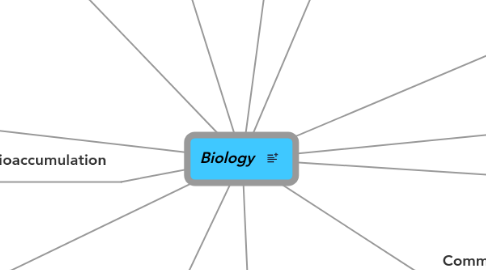
1. Orginization
1.1. Biosphere
1.1.1. The enire world's ecosystems combined
1.2. Ecosystem
1.2.1. A larger community
1.3. Community
1.3.1. A group of populations
1.4. Population
1.4.1. A group of the same orginisms
1.5. Orginisim
1.5.1. A lving thing
2. Ecological Roles
2.1. Producers
2.2. Consumers
2.2.1. Types
2.2.1.1. Secondary
2.2.1.1.1. Consume Producers
2.2.1.2. Teritary
2.2.1.2.1. Consume Secondary
2.3. Decomoposers
2.3.1. Recycle energy
2.4. Energy flow
2.4.1. The Dition in which energy flows through a food chain
3. Trophic Levels
3.1. Food Web
3.2. Food Chain
4. Cycles
4.1. Carbon
4.2. Phosphourus
4.3. Nitrogen
4.4. Preditor Prey Cycle
5. Extremeophiles
5.1. Acidophile
5.1.1. Very Acidic Enviroments
5.2. Alkaliphile
5.2.1. Very Basic Enviroments
5.3. Endolith
5.3.1. Deep Enviroments
5.4. Xerophiles
5.4.1. Driest Enviroments
5.5. Polyextemophiles
5.5.1. Multiple extreme Enviroments
5.6. Hyperthermophile
5.6.1. Very Hot enviroments
6. Bioaccumulation
6.1. Biomagnification
6.1.1. The further up the food chain bioaccumulation goes
6.2. When toxins accumulate in orginisms
7. Factors
7.1. Biotic
7.1.1. Factors effeced by biolgical factors.
7.2. Abiotic
7.2.1. Factors that are not biological
8. Symbosis
8.1. Mutuaism
8.1.1. Where both orginisms benefit
8.2. Commensalism
8.2.1. One Orgism benefits, the other is unharmed
8.3. Parasitism
8.3.1. Were a parisite feeds off a host
9. Biomes
9.1. Borreal Forest
9.2. Temperate Rainforest
9.3. Grassland
9.3.1. Tropical
9.3.2. Temperate
9.4. Tundra
9.5. Temperate Deciduous Forest
9.6. Tropical Rainforset
9.7. Desert
9.7.1. Cold
9.7.2. Hot
9.8. Permanent Ice
10. Evolution
10.1. Adaptaion
10.1.1. Adaptive Radiation
10.2. Natural selection
10.2.1. Profileration
10.3. Mimicry
10.4. Coevoluion
10.4.1. When prey evolve to match
10.5. Biodiversity
11. Community
11.1. Climax community
11.2. Extinction
11.3. Extripation
11.4. Keystone Species
11.5. Ecological Sucession
12. Competition
12.1. Interspecific
12.1.1. Bettween diffrent species
12.2. Intraspecific
12.2.1. Within the same species
